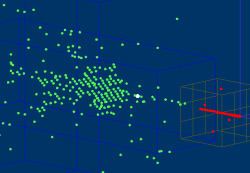 | ||
The CALICE (CAlorimeter for LInear Collider Experiment) collaboration [1] is an R&D group of more than 280 physicists and engineers from around the world, working together to develop new, high performance detectors for high energy positron-electron (
The physics requirements of a future TeV-scale
The calorimeter systems for high energy physics experiments usually consist of three main subsystems: electromagnetic calorimeter (ECAL) to detect electromagnetic showers produced by electrons (or positrons) and photons, hadronic calorimeter (HCAL) to measure hadron-induced showers, and muon tracker (or so-called tail catcher) to identify highly penetrating particles such as muons.
CALICE has developed prototypes of the three main calorimetric subsystems of a future detector: an ECAL followed by an HCAL and a tail catcher/muon tracker (TCMT), and is evaluating the performance of alternative technological solutions within this combined system.
The collaboration studies the performance of such calorimeters within a long, detailed program for an ECAL and several options of high granular analogue and digital calorimeters with sensitive layers of gas or plastic scintillator. The Tile- subgroup [2] has built a 1
High granularity is achieved by 38 scintillator tile layers . Each layer is a 2-
The mosaic of the HCAL layers exhibits a hundred 3x3
Present status
The very important experimental part of this project is now in progress: a combined test beam program involving exposure of combined prototype calorimeter system to real particle beams from different accelerators and subsequent data analysis. In test beam studies the Tile-HCAL with effective thickness 4.5 nuclear interaction lengths (
For today, the sampling calorimeter has been calibrated to get its signal vs. the incident particle energy dependence using test beams of different incident particle sorts with known energies in the range from 4 GeV to 120 GeV. The corrections for the calorimeter non-linearity and the external temperature influence have been taken into rooster. For test beams with energy 50 GeV the precision of incoming particle energy reconstruction was estimated to be near 4%.
Now, given some number of unknown incoming particles, it is possible to reconstruct their energies using the picture of particle showers born in the calorimeter. That picture have to be analyzed by a PFA program . In addition novel Deep Analysis (DA) algorithm has been developed to separate different sorts of secondary particles inside showers in order to improve the energy reconstruction.
The unprecedented granularity of CALICE calorimeter prototype provides an opportunity to test the Particle Flow concept. These days the work is in progress to check the output quality of the PFA programs . Due to large amount of test beam data, it becomes possible to use real events instead of simulated ones as input information for that programs. Since in the test beams all the particles are almost at the same coordinate position, there are created artificial events consisting of several incoming particles separated by some distance in order to check if the PFA program could to reconstruct the incoming particles right.
